Hot peppers are distinguished from sweet peppers simply by their pungency or hotness of flavor. There are thousands of hot pepper varieties in the world. (This is the case because peppers easily cross-pollinate to produce new kinds.)
The hotness of a pepper is determined by a number of blister-like sacs of capsaicinoids on the interior wall of the pepper. Capsaicinoids are organic chemicals. The more sacs of capsaicinoids the hotter the pepper.
Related articles:
- Five Ways to Cook and Serve Sweet Peppers
- Five Ways to Cook and Serve Chili Peppers
- Pepper Seed Starting Tips
- Six Tips to Grow Peppers for Flavor
- 7 Tips for Growing Peppers in Pots
- How to Harvest and Store Peppers
- How to Grow Sweet Bell Peppers
- How to Plant and Grow Hot Peppers
- Pepper Growing Problems Troubleshooting

About hot peppers
Hot peppers are tender perennials that are grown as annuals. Peppers grow on compact erect bushes usually 1½ to 2 feet (46-61 cm) tall, but they can grow taller. The fruit follows a single flower growing in the angle between the leaf and the stem. Hot peppers–also called chili peppers–vary in shape and color and include the bell-shaped pepper, the heart-shaped pimiento, the short and long podded yellow wax, the conical-shaped jalapeño, and the cayenne. Because peppers easily cross-pollinate there are thousands of different hot peppers. Hot peppers vary in hotness or pungency. The hotness of a pepper is determined by the number of blister-like sacs of capsaicinoids (organic chemicals) on the interior wall of the pepper. The more sacs the greater the hotness of the pepper.
Good Products for Growing Peppers at Amazon:
- Espoma Garden Tone 3-4-4 Fertilizer
- Epsom Salt Plus Plant Nutrients Magriculture
- Tomato Grower’s Answer Book
- Neem Bliss 100-% Cold Pressed Neem Oil
- Safer Brand Insect Killing Soap
- Monterey BT Caterpillar Killer
- Southern Ag Liquid Copper Fungicide
- Harris Diatomaceous Earth with Duster
- Natures Good Guys Beneficial Nematodes
Hot peppers go by several names. Most commonly hot peppers are called chili peppers in the United States. ‘Chile’ is Spanish for pepper. In Mexico, chile dulce is a sweet pepper and chile jalapeño is a jalapeño pepper. When the name chile first came to the United States it was used to mean different kinds of peppers in different parts of the country. In time, the spelling “chile” was eventually corrupted to “chili” and the term came to be commonly used to describe any pepper that was hot flavored
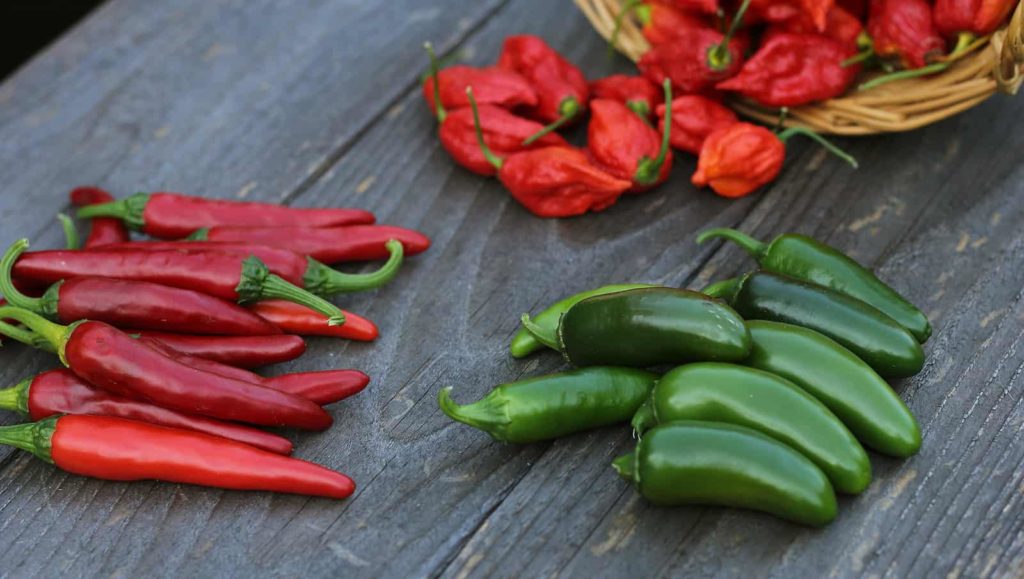
How to choose a hot pepper for your garden
The potent spicy heat you experience eating chili peppers is caused by capsaicin, a colorless, odorless, waxy compound found in the white pith of the pepper’s inner wall where the seeds are attached.
Capsaicin is an irritant to most mammals—including humans; the sensation it leaves when it comes in contact with mucus membranes of most herbivores is one of burning—thus we commonly classify chili peppers by their heat or bite. The more capsaicin in a chili—actually measured chemically in parts per million—the hotter the pepper.
Measuring pepper heat: Scoville Scale
The measure for capsaicin pungency in peppers is called the Scoville scale, named for American pharmacist Wilbur Scoville who developed the scale in 1912. The greater the number of units on the Scoville scale the hotter the pepper. A sweet bell pepper has 0 Scoville heat units (SHUs); the Naga Viper pepper, one of the world’s hottest peppers, has 1,382,118 SHU; by comparison, a jalapeño pepper—hot enough to cause most humans some discomfort–has 2,500 to 8,000 SHU.
The shape and size of chili peppers were once a sure indicator of a pepper’s heat; tiny and small and long and thin peppers would be hot, but pepper breeders have changed all that—today you can find jalapeños and other chiles that have been bred to be mild.
The best way to know how hot a pepper is: read the grower’s description, the plant label, or the seed packet and look for these descriptors–mild, hot, or very hot. And, of course, tasting is a sure way to understand a pepper’s heat, but it is best to err on the side of caution if you are unsure of a pepper’s pungency—begin with a small amount and increase the amount as you get used to it. (The antidote to pepper burn on the tongue: bananas, milk, yogurt, and granulated sugar are often mentioned by pepper lovers.)
Heat range of peppers commonly grown in home vegetable gardens
(OP=open-pollinated, which means you can save the seeds and plant them again next season; and growing days to maturity from transplanting into the garden)
- Bhut Jolokia (also called Ghost Pepper): 1,001,304 SHU (OP, 100days)
- Scotch Bonnet: 100,000-580,000 SHU (OP, 120 days)
- Habanero: 100,000-500,000 SHU (OP, 90-100 days)
- Jamaican Hot: 100,000-200,000 SHU (OP, 95 days)
- Chiltepin: 100,000 SHU (OP, 95 days)
- Thai: 50,000-100,000 SHU (OP, 90 days)
- Cayenne: 30,000-50,000 SHU (OP, 72 days)
- Aji: 30,000-50,000 SHU (OP 85-90 days)
- Tabasco: 30,000-50,000 SHU (OP, 80 days)
- Serrano: 8,000-23,000 SHU (OP, 75-80 days)
- Mirasol: 5,000 SHU (OP, 100 days)
- Jalapeño: 2,500-9,000 SHU (OP, 75 days)
- Fresno: 2,500-8,500 SHU (75 days)
- Hungarian Wax: 1,000-15,000 (OP, 70 days)
- Ancho: 1,000-2,000 (OP, 76-80 days)
- Poblano: 500-2,000 SHU (OP, 75-80 days)
- Santa Fe: 500-700 SHU (75-80 days)
- Anaheim: 250-1,400 SHU (OP-75 days)
- Pepperoncini: 100-500 SHU (OP, 62 days)
- Paprika (several peppers are used for paprika) 50-200 SHU
- Pimento: 0 SHU (OP, 100 days)
- Sweet Banana: 0 SHU (OP, 72 days)
- Sweet Bell: 0 SHU
Yield–how many hot peppers to plant
- Plant 5 to 6 hot pepper plants per household member. Determine how you plan to use the hot peppers and plant varieties according to the hotness of the pepper desired. A single serrano pepper plant will produce 50 fruits.
Where to plant hot peppers
Plant peppers in compost-rich, well-drained soil. Pre-heat planting beds by covering them with black polyethylene sheeting 1 week before transplanting. Move seedlings to a sheltered place outside to “harden off” 1 week before transplanting. Space plants in the garden 18 inches (45 cm) apart; rows should be 24 inches (61 cm) apart. Keep the soil just moist throughout the growing season–watering deeply as the season progresses.
- Grow peppers in full sun (at least 6 hours per day) in soil that is rich in organic matter, moisture-retentive but well-draining.
- Peppers prefer a soil pH of 6.0 to 6.8. If the pH is below 6.0 add limestone to the soil; if the pH is above 8.0 add aged compost to lower the pH. A safe bet is to always work aged garden compost into beds prior to planting.
- The optimal soil temperature for peppers is 65°F (18°C) or warmer.
- Choose a site protected from the wind.
- Avoid planting in beds where other members of the Solanaceae family (peppers, eggplants, tomatoes, and potatoes) have recently grown.
- Some peppers such as Jalapeño, cayenne, and mirasol prefer arid regions; others such as habanero, Scotch bonnet, and datil prefer humid regions.
When to plant hot peppers
Sow pepper seeds indoors 8 to10 weeks before transplanting them into the garden. Sow seed directly in the garden only in long-summer regions
Start pepper seeds in a warm, well-lighted location—in a bright window or under grow lights. Sow 1 or 2 seeds ¼” (6 mm ) deep in individual containers with seed starting mix. Keep mix just moist. Seedlings emerge in 11 to 21 days at 75-80°F (24-26°C). Thin seedlings to 1 plant per container once plants are 2-3” (5-7 cm) tall.
Transplant pepper seedlings to the garden 2 to 3 weeks after the last frost.
- Generally, you can set out peppers at the same time you set tomatoes or basil into the garden.
- Hot peppers grow best in daytime air temperatures of 65° to 80°F (18-26°C) and night temperatures above 55°F /13°C (nighttime temperatures between 60° and 70° are best).
- Peppers are most easily grown from transplants. Start seed indoors 7 to 10 weeks before the date you intend to set peppers into the garden.
- Peppers can be seeded in the garden or transplanted out 2 to 3 weeks after the last frost in spring after the soil temperature has risen to at least 65°F.
- In temperatures greater than 85°F (29°C), peppers may drop their blossoms although set fruit will ripen.
- The ideal temperature for hot peppers is a daytime temperature near 75°F (24°C) and a nighttime temperature near 62°F.
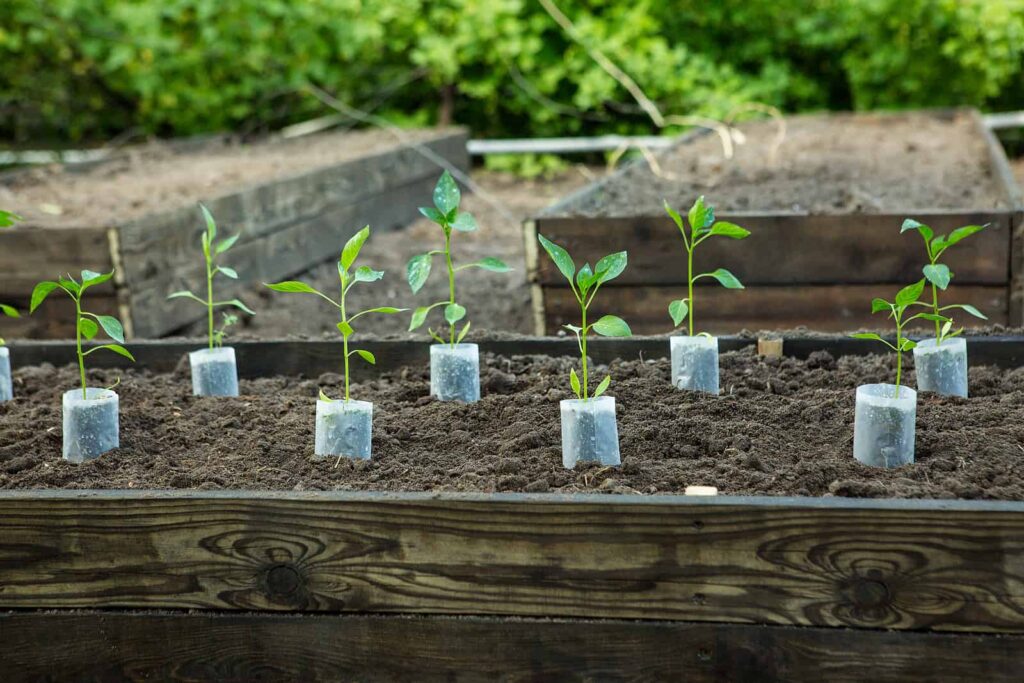
Planting and spacing hot peppers
- Sow hot pepper seeds ¼ to ½ inch deep, 18 to 24 inches (45-61 cm) apart depending upon the variety.
- Space rows 24 to 36 inches (61-91 cm) apart.
- Sow three seeds to each spot or pot and thin to the two most successful seedlings.
- Peppers can be transplanted into the garden when they are 4 to 6 inches (10-15 cm) tall.
Watering and feeding hot peppers
- Keep peppers evenly moist but not wet particularly when blossoms appear and fruit begins to form. Soil that goes too dry can result in blossom drop.
- Keep the soil evenly moist just after transplanting peppers to the garden; avoid under or over-watering peppers early on. Add aged compost to planting beds before planting and again at midseason.
- Once hot pepper plants are established you can vary the watering.
- Close to harvest hot peppers that are deprived of water and become slightly stressed will produce more pungent fruit.
Companion plants for hot peppers
- Grow hot peppers with beets, garlic, onions, parsnips, and radishes.
Good Products for Raised Bed Growing at Amazon:
- Galvanized Raised Bed 8×3
- Cedar Raised Bed 4×8
- Elevated Cedar Planter 4×2
- Walk-In Greenhouse Tunnel 15x7x7
- Row Cover for Freeze Protection 10×30
Caring for hot peppers
- Keep planting beds well-weeded to avoid competition. Peppers are shallow-rooted, so cultivate around peppers with care. Mulch to keep soil temperature and moisture even.
- Avoid high nitrogen fertilizers which will create large leafy plants with few or no fruits. High temperatures and wind can cause flowers to drop and plants not to set fruit.
- Plastic mulch can improve pepper yields. Organic compost mulches will reduce weeding and watering, but not fruit yields.
- Hot peppers can put out shoots that become leggy. Cut these shoots back to keep the plant compact.
- Peppers will begin to flower almost as soon as the plant forms branches. Pepper plants have complete flowers which means each flower contains both a male and female part; as a result, the pepper is self-pollinating. Wind, bees, and other insects, and a slight shake of the plant by a human hand can aid pollination.
Container-growing hot peppers
- Peppers can be grown in a large container. An 8-inch (20 cm) pot will accommodate a single plant.
- In larger containers, set plants on 12-inch (30 cm) centers.
- Peppers can be grown indoors. Peppers started indoors before the last frost in spring will get a head start on the season. Extend the season in the fall by moving plants indoors if frost threatens or if temperatures warm to greater than 90°F (32°C). Bring outdoor started peppers inside for a few hours a day at first until they get used to the lower light available indoors.
Hot pepper pests
- Peppers can be attacked by aphids, cutworms, flea beetles, and hornworms.
- Discourage cutworms by placing a collar around each transplant at the time of planting; handpick hornworms off of plants.
- Flea beetles and aphids can be partially controlled by hosing them off the plants and pinching out infested foliage.
Hot pepper diseases
- Peppers are susceptible to rot, blossom end rot, anthracnose, tobacco mosaic virus, bacterial spot, and mildew. Plant disease-resistant varieties.
- Keep the garden clean and free of weeds where pests and diseases can shelter. Remove infected plants before a disease can spread.
- If you smoke, wash your hands before working with the plants to avoid spreading the tobacco mosaic virus.
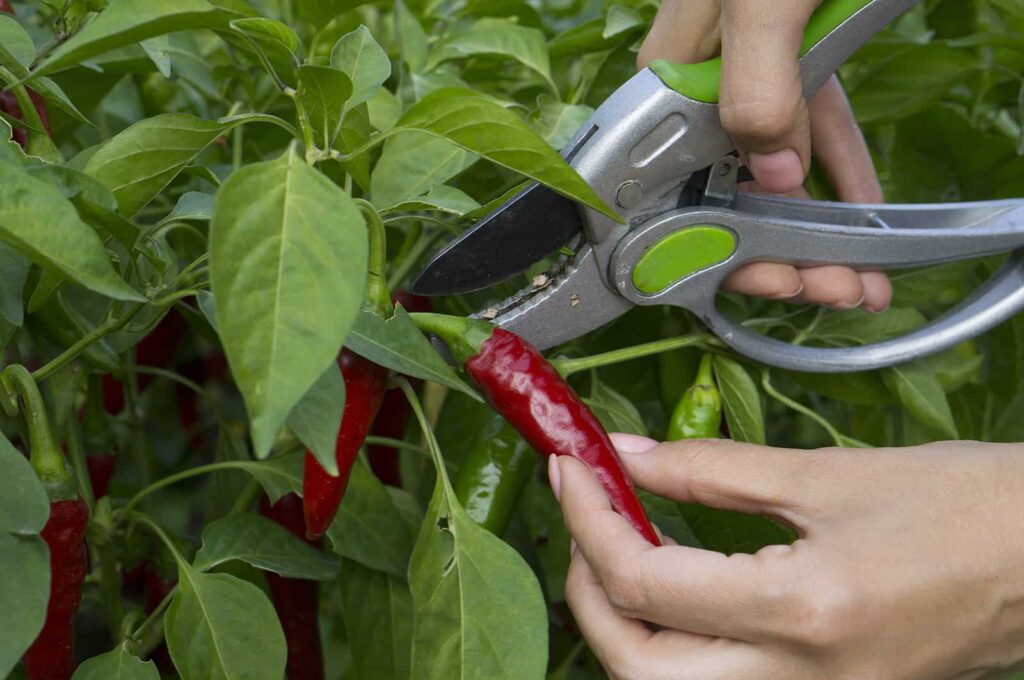
How to harvest hot peppers
For full flavor allow hot peppers to ripen to maturity and full color. Note days to maturity on your calendar when you set out transplants.
- Hot peppers are ready for harvest about 60 to 95 days after sowing depending upon the variety.
- Most hot peppers mature from green to red as the seeds inside mature.
- Green hot peppers are not ripe, although some people prefer the flavor of green hot peppers.
- Red peppers are ripe and have a fruitier flavor.
- The hottest chili peppers are usually orange-colored.
- Cut the peppers off the vine. Pulling a pepper away from the plant may cause the plant to come out of the soil.
- To prolong the harvest, cut peppers from the plant regularly; a hot pepper harvest can last from one to three months.
Harvest safety
- Hot peppers contain organic chemicals called capsaicinoids which can burn the skin and eyes. Wear rubber gloves when harvesting hot peppers and be careful not to rub your eyes. The best antidote for burning skin is to rub them with isopropyl (rubbing) alcohol.

Hot pepper varieties
There are more than 200 varieties of chilies or hot peppers. Sometimes the names of chilies can get a bit confusing because often the same pepper will be known by two or even three different names. All of these peppers are members of the genus Capsicum. The species name is given in parentheses. The Scoville heat unit (SU) or pungency rating is listed for many.
- Ají amarillo (C. baccatum): Pointed, thin-fleshed with yellow to orange-red skin. Fragrant fruity to raisiny aroma. Use fresh or dried; when dried called cusqueño. Use with potatoes and other root vegetables, in sauces, stews, seviches, and other seafood dishes. Popular in Peru. 30,000 to 50,000 SU.
- Ají dulce (C. annuum): Sweet, mild, and musky herbal-like flavor. Used especially with beans. Popular in Central America, Colombia, and Venezuela.
- Anaheim (C. annuum): Also called New Mexico pepper (Anaheim is a cultivar of New Mexico), Rio Grande pepper, long green chile, or California pepper: Green matures to red pepper, slender, 6 to 8 inches (15-20 cm) long with blunt end. Considered mild green or red. Use fresh, roasted, fried, or dried and ground. Use to make chiles rellenos: fried, cheese-stuffed chiles. Use dried and ground for chili powder and paprika. Developed in Anaheim, California about 1900. 500 to 1,500 SU.
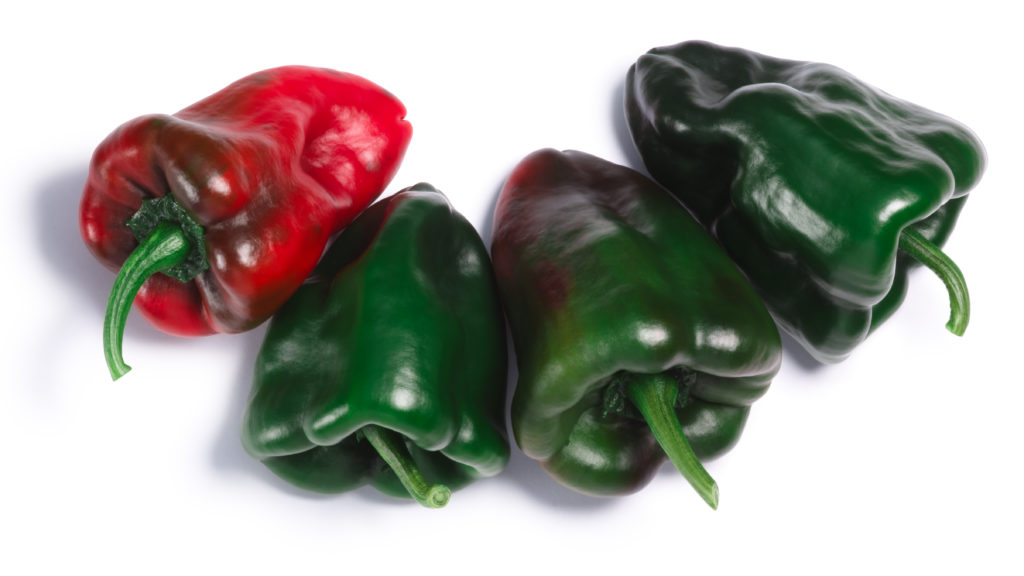
- Ancho (C. annuum): Large to about 5 inches (13 cm) long, lobed, heart-shaped fruit-colored green maturing to dark brown to brick red. Sweet, mildly pungent, fruit-flavored flesh. Ancho is a ripened and dried Pablano pepper. Sometimes the fresh pablano is misidentified as the Ancho. Used ground to thicken cooked sauces such as mole. Perhaps the most popular chili in Mexico; is named for the valley of Puebla south of Mexico City. Looks like a dried mulato chile. 1,000 to 1,500 SU.
- Arból chile (C. annuum): Also called chile de arból: Bright red fresh or dried, slender curved, and pointed with thin flesh and smooth skin, 2 to 3 inches (5-7.5 cm) long. Somewhat tannic flavor Use in salsa and soups. Soaked and puréed used in stews and as a table sauce. Popular in Mexico. Arbol means tree in Spanish. 15,000 to 30,000 SU.
Good Products for Seed Starting Success at Amazon:
- Jump Start Germination Station w/Heat Mat Tray, 72-Cell Pack, Dome
- Espoma Seed Starting Mix
- 200 Count- Jiffy 7 Peat Soil Seed Starting Plugs
- Seed Starter Kit with Humidity Dome (120 Cells Total Tray)
- AgrobriteT5 Fluorescent, 2-Foot, Grow Light System
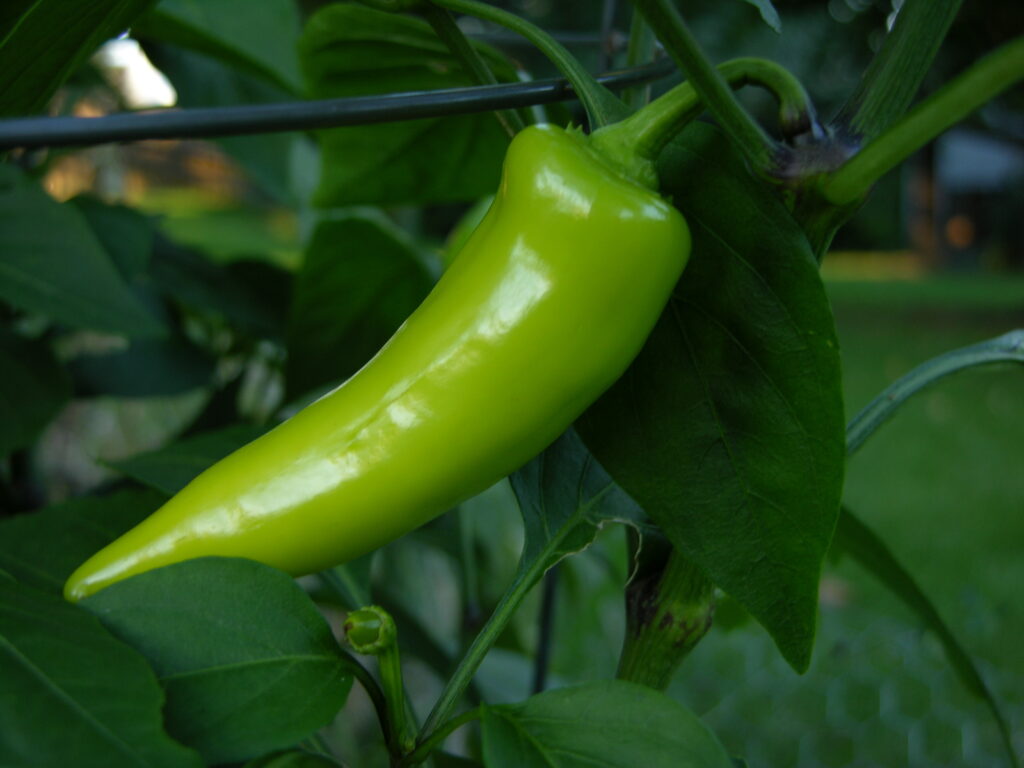
- Banana (C. annuum): Yellow-green ripening to red, curved with a waxy skin. Use fresh in salads, and stews, roasted whole with legumes or potatoes, pickled, and used as a garnish. Mild chili related to the hotter Hungarian wax. 0 to 100 SU.
- Bird (C. frutescens): Also called bird’s eye chile and Santaka. Tiny, green, orange, and red-skinned. Thin-skinned. Used as a finishing flavor. Popular in Asia. 40,000 to 60,000 SU.
- Cascabel (C. annuum): Round to button mushroom-shaped with brown-red, smooth, translucent skin about ¾ inch (1.9 cm) in diameter at maturity. Lightly acidic, smoky flavored; nutty tasting after toasting. Cascabel means “jingle bells” because the seeds rattle in the pod. Blend with tomatoes or tomatillos to make salsas. Use crumbled-in stews. Popular in Mexico. 1,500 to 2,500 SU.
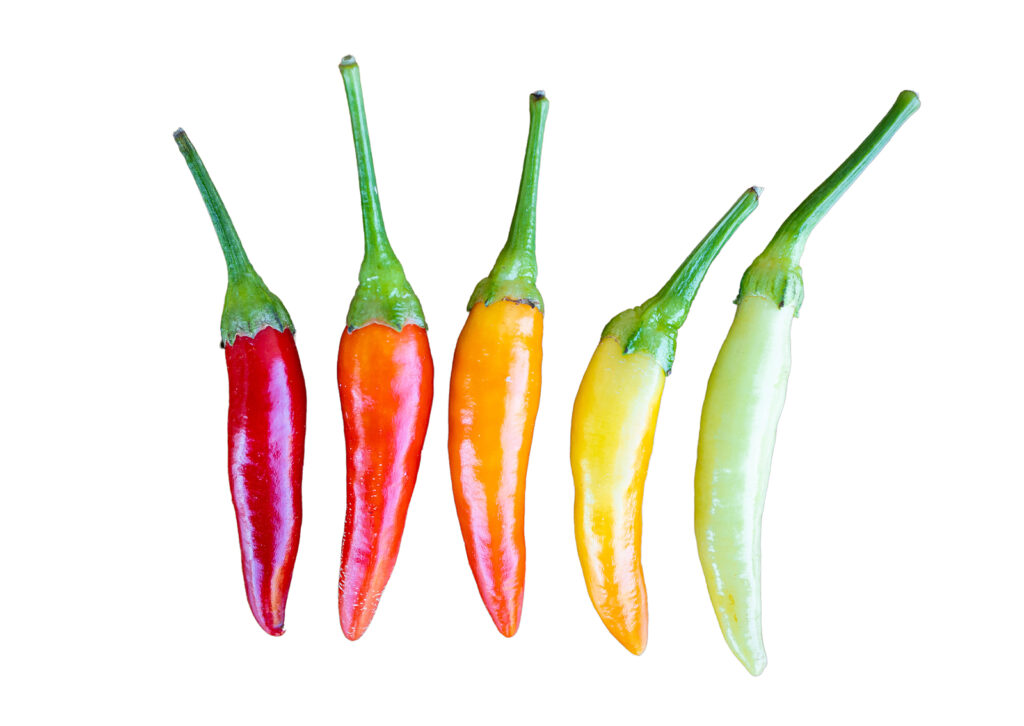
Red and yellow chili cayenne peppers
- Cayenne (C. annuum): Sometimes mistakenly called Chile de arból or Thai pepper. Slender, thin, tapered pods 4 to 12 inches (10-30 cm) long, green maturing to red and wrinkled. Dried cayenne can be soaked in vinegar and salt for a few days to make a pungent, liquid hot red pepper sauce. Dried and ground is made into a powder to use in sauces such as Tabasco or as cayenne pepper. Named for the city of Cayenne in French Guiana where it may have originated. 10,000 to 50,000 SU.
- Cherry (C. annuum): Also called cherry hots. Meaty, somewhat flattened, cherry-shaped, light green maturing to orange to bright red. Mahogany colored when dried. Lots of seeds. Fruity, sweet flavor. Harvested at green or red stage. Pickled and bottled. Use added to salads, antipasto platters, or sandwich platters.
- Chilaca (C. annuum): Thin, 6 to 12 inches (15 to 30 cm) long, deep red-brown, and shiny, with vertical ridges; blackish-green when immature. The deep flavor has a hint of licorice. Roasted and peeled used in vegetable dishes with cheese and in sauces. Use in salsas. Sometimes available pickled. Hard to find in the dried version. Popular in Mexico. 1,000 to 1,500 SU.
Seeds for Success at Amazon:
- 55 Heirloom Vegetable Seed Varieties
- 32 Variety Pack Survival Gear Food Seeds | Non-GMO
- 60 Cell Seed Starter Kit with Grow Lights
- Durable Waterproof Seedling Heat Mat
- Chipotle (C. annuum): Dried jalapẽno. Tan to coffee-colored, wrinkled, and leathery; smoky, sweet, chocolate smell and taste. Use to flavor soups and stews. Soaked and pureed, use in sauces. In a light pickle, use it as a condiment. Popular in Mexico.
- Chiltecpín (C. annuum): Also known as chilipiquin and tepín. One of the so-called bird peppers. Red, very small, egg-shaped fruit; oval to elongate about the size and shape of a cranberry. Use fresh and dried. Chiltecpín in the Nahuatl language of Mexico means flea-chili because this chili is very small with a sharp bite. Believed to be the oldest of the Capsicum genus. 50,000 to 100,000 SU.
- Choricero (C. annuum): Large bell-shaped. Use to flavor chorizo and other meats.
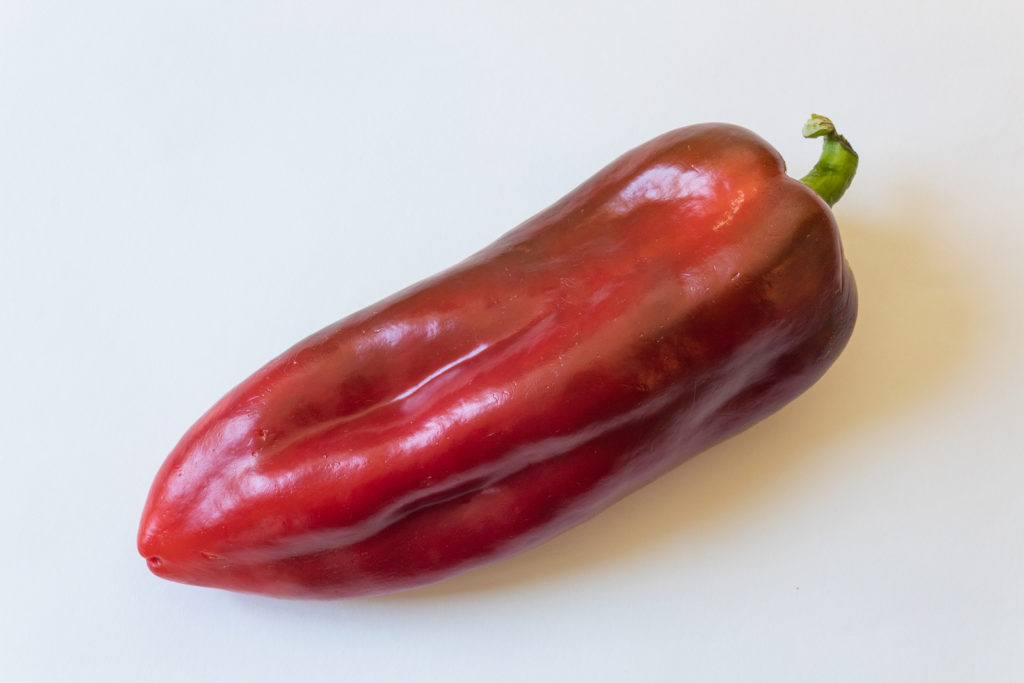
- Cuban: Also called Cubanelle or Italian frying pepper. Large, irregular, and blocky shaped; light green to yellow to red at maturity. Thin-skinned. Harvest at all stages. Mild flavored and excellent for frying.
- De arból: same as Arból chile above.
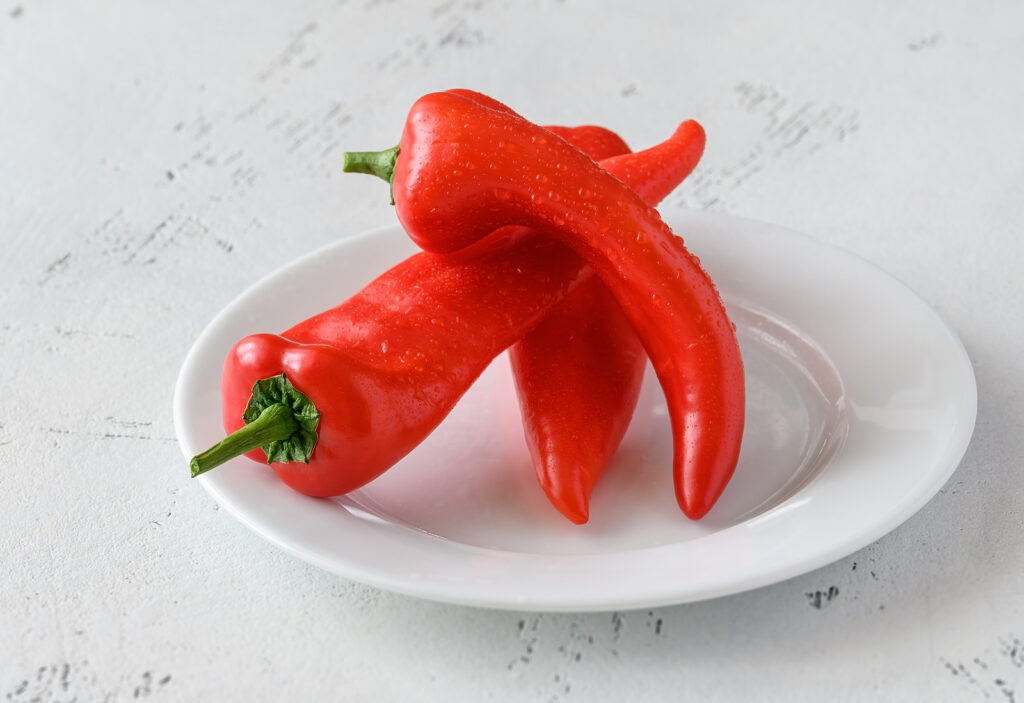
- Fresno (C. annuum): Wide, stubby to cone-shaped, 2 to 3 inches (5-7.5 cm) long, green when immature and red when ripe; thick fleshed but not as thick as the jalapeño. Use green for seasoning and in sauces. Use in salsa and cooking and for pickling. Named for the city in California where first grown in the early 1950s. 5,000 to 10,000 SU.
- Guajillo (C. annuum): The red dried form of Mirasol. Also called “little gourd” because the seeds in a dried pod, rattle. Large, tapered fruit; 4½ to 5½ (11.3-14.3 cm) long with a blunt point; maroon with brown tones, and smooth, leathery tough skin. High acidity gives a tangy and pleasantly sharp taste. Use dried and ground in chili, soup, or salsa. Soak and blend for enchilada sauces. Crumble into stews. Popular in Mexico. 2,500 to 5,000 SU.
- Güero (C. annuum): Pale yellow, smooth, conical to 3 to 4 inches (7.5-10 cm) long and 1 inch (2.5 cm) wide with thin flesh. The taste is lightly floral. Use fresh in salsas and moles. Popular in Mexico. Mild to medium-hot.
- Guindilla (C. annuum): Deep red and smooth, long and tapering. Use dried. Large pieces are soaked and added to dishes for extra piquancy. Remove before serving. Popular in Spain.
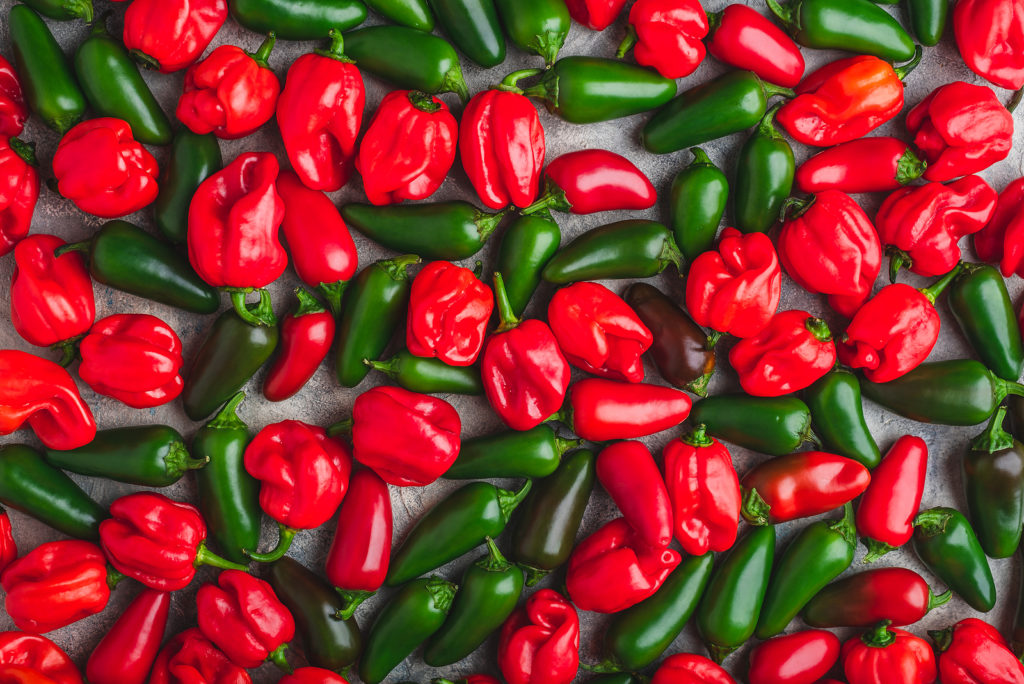
- Habaneros (C. chinense): Squat, lantern-shaped pods 1 to 2 inches (2.5-5 cm) in diameter; mid-green ripening to yellow, orange, and deep red. Thin fleshed and tropical fruit flavor. Use raw or roasted to flavor beans and sauces. Use to make the hot sauce: blend roasted habaneros with salt and lime juice. May have originated in Cuba; the name means “from Havana.” Very popular in the Yucatan region of Mexico. Related Scotch bonnet. 100,000 to 500,000 SU.
- Hungarian yellow wax (C. annuum): Also called banana pepper, hot wax pepper. Uniform, tapered, shiny, yellow pepper growing to about 6 to 7 inches (15-18 cm) long. Medium-thick walls. Popular for pickling and canning. 5,000 to 50,000 SU.
- Jalapẽno (C. annuum): Small, cylindrical to blunt oval pods or torpedo-shaped, about 2 inches (5 cm) long with smooth, green-russeted thick skin, often striated with brown lines; usually harvested green. Often pickled with carrots and onions served as a table relish. Use minced in salsa or spilt and deveined stuffed with cheese or fish and served as an appetizer. Sometimes used roasted and peeled. Called chipotle when dried and smoked. Adds zest to tacos, hamburgers, cheese dishes, and pizza. Popular in Mexico and the southwestern United States. Named for the town of Jalapa in Veracruz state Mexico. 5,000 to 10,000 SU.
- Jamaican hot (C. chinense): Also called Scotch bonnet (see below): Bright red and squat with thin flesh; tastes sweet and very hot; Use in salsas, pickles, and curries. Popular in the Caribbean.
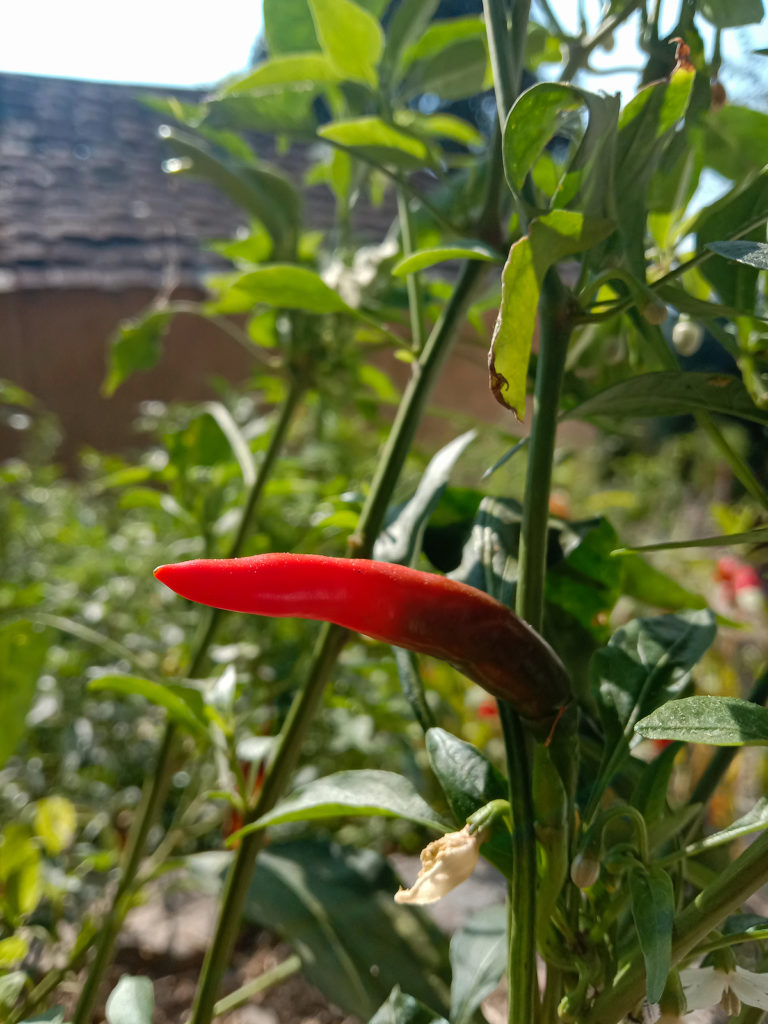
- Kashmiri (C. annuum): Deep red with sweet notes and a distinct bite. Grows in Kashmir and in other parts of India. Called lal mirch in India.
- Korean (C. annuum): Bright green, cured. Use fresh cooked with fish, meats, and vegetable stews, in stir-fries or stuffed and fried. Related to the Thai pepper.
- Long Wax (C. annuum): Long and tapered to a point, although some are blunt; tolerates low and high temperatures; harvested at green, yellow, and red stages. Mildly pungent.
- Malagueta (C. frutescens): Small, tapered, and thin-fleshed with pale to mid-green skin. Native to Bahia in Brazil, and widely used in Afro-Brazilian cooking and as a table condiment. In Portugal, the name is used to describe small hot chilies pickled in vinegar.

- Mirasol (C. annuum): Fresh, yellow form of Guajillo (see above). Use green, yellow, or at the ripe red-brown stage. Fruity and lively, color dishes well. Good with meats, beans, and vegetables; stews and sauces. The fruit grows pointing up at the sun. Spanish name means “looking at the sun.” Popular in Peru, also used in Mexico. 2,500 to 5,000 SU.
- Mulato (C. annuum): Flat wide, wrinkled, about 4 inches (10 cm) long, chocolate brown color with full-bodied, sweet flavor with notes of dried cherries. Similar to Ancho. Use toasted and ground for sauces such as mole. Use in salsa, soups, and stews. Popular in Mexico. Mild to medium-hot.
- New Mexico (C. annuum): Slender, tapered, 4 to 6 inches (10-15 cm) long; harvested green, yellow, orange, and red. Has a sweet, earthy flavor. Use stuffed. Green is good in guacamole, tacos, and tamales; red in sauces, soups, relishes, and chutneys. Roast and peel. Keeps well if frozen after roasting. Dried has a rich, dried-fruit flavor. Anaheim is a popular cultivar. Popular in the Southwestern United States; mainly grown along the Rio Grande River. 500 to 1,000 SU.
- Ñora (C. annuum): Mild and earthy. Soaked and used to flavor rice dishes and stews. Essential to romesco sauce and sweet paprika.
- Pasilla (C. annuum): Long, narrow pods to about 6 inches (15 cm) long with 1 inch (2.5 cm) wide shoulders; fresh is dark green to nearly black color which dries black and wrinkled; thus the name which is the diminutive form of pasa which means raisin. Fresh pods that reach Latin markets are called chile chilacas. Fresh ones are toasted and skinned before use in recipes; often cut into strips for use in soups, stews, and casseroles. The dried form is mild, chewy, and smoky-sweet. Use dried and ground to thicken mole sauces. In California, the term pasilla is incorrectly attributed to pablanos. Popular in Mexico. 1,000 to 1,500 SU.
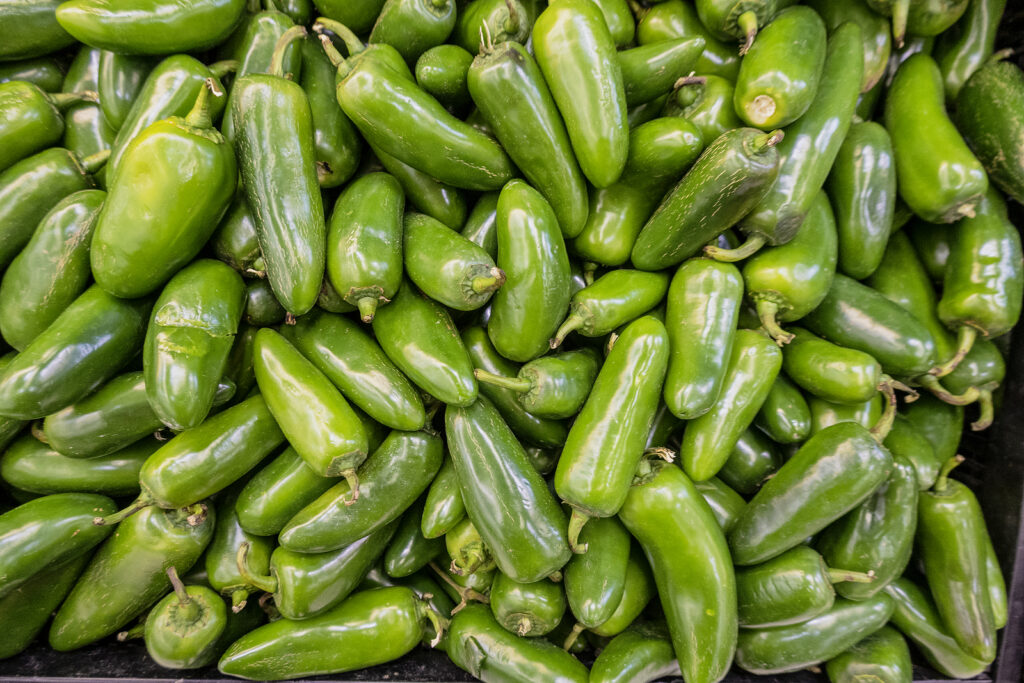
- Pablano (C. annuum): Large, shaped like a long, pointed heart ranging from 2½ to 6 inches (6.4-15 cm) long, deep green. Dried and smoked form is called Ancho. Mistakenly pasilla in California. Use roasted and peeled in some recipes, cut into strips for casseroles, soups, and sauces. Thick walls are ideal for stuffing; used to make stuffed chile rellenos. Originated in Puebla region south of Mexico City. 1,000 to 1,500 SU.
- Pepperoncini (C. annuum): Small, slender, and wrinkled, often curves with thin flesh. Use fresh, green ripening to red. Sweet flavor. Use in pickles and tomato-based dishes. Serve pickled on green salads and antipasto plates. 100 to 500 SU.
- Pequín: Also called piquin. Tapered to 2 inches (2.5 cm) long with orange skin. Use dried. Similar to cayenne in flavor but much hotter. 50,000 to 100,000 SU.
- Piri piri (C. chinense) or peri peri: Small; Portuguese name for “small chili pepper.” Name used in parts of the world colonized by the Portuguese. Originated in Brazil. In Africa, used in jindungo chili similar to bird chili. Sold marinated in oil, as a power and as a purée. Add to meat, vegetables, and fish. Best known dish is frango grehado con piri-piri or grilled chicken marinated in piri-piri. 30,000 to 50,000 SU.
- Piment d’Espelette (C. annuum): Bright red, wide-shouldered, and tapering. Available dried, whole, or as a powder and also as a purée or coulis. From the Basque country. Sweetly fruity and mildly piquant.
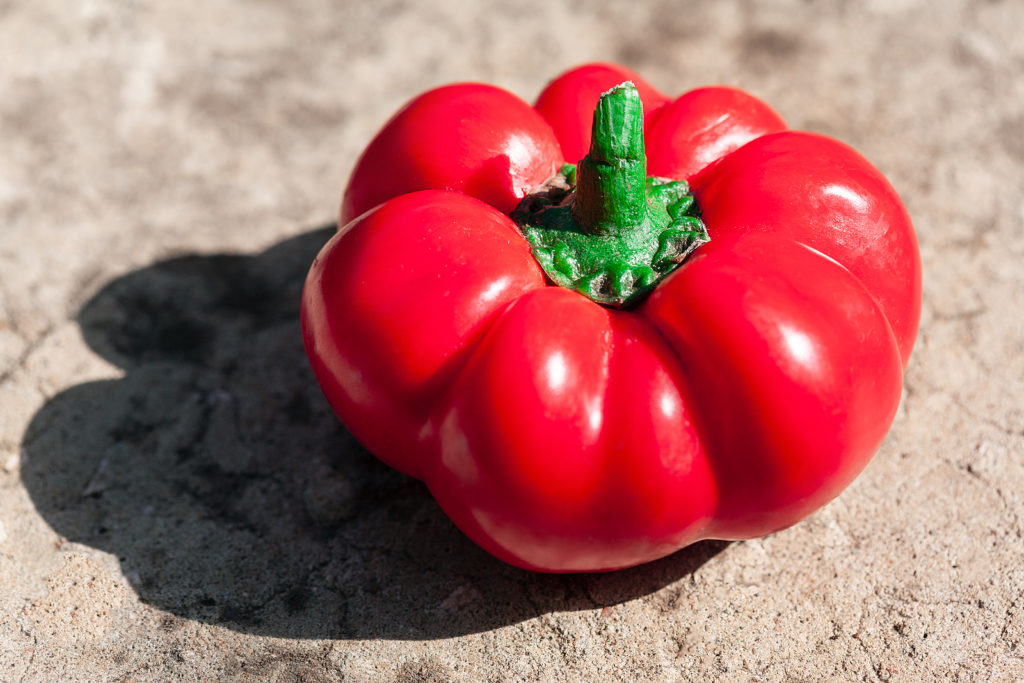
- Pimiento (C. annuum): Also called pimento. Red heart-shaped, fleshy, mild, and sweet pepper. Use roasted or to stuff green olives. Use dried and ground to make paprika. 500 or less SU.
- Rocotillo (C. chinense): Squat to squashed looking resembling a tiny pattypan squash, 1 to 1½ inches (2.5-3.4) inches in diameter; green to gold to bright red at maturity. Deep red when ripe. Use as a condiment with corn, beans, root vegetables, and roast meats. Use fresh in hot sauces and salsa; mild enough to use raw. Originated in the Caribbean. 1,500 to 2,500 SU.
- Rocoto (C. pubescens): Plump and rounded, yellow to orange-red. Used fresh in sauces and condiments or as a vegetable. Often stuffed with meat and cheese. Popular in South America. Native to the Andes.
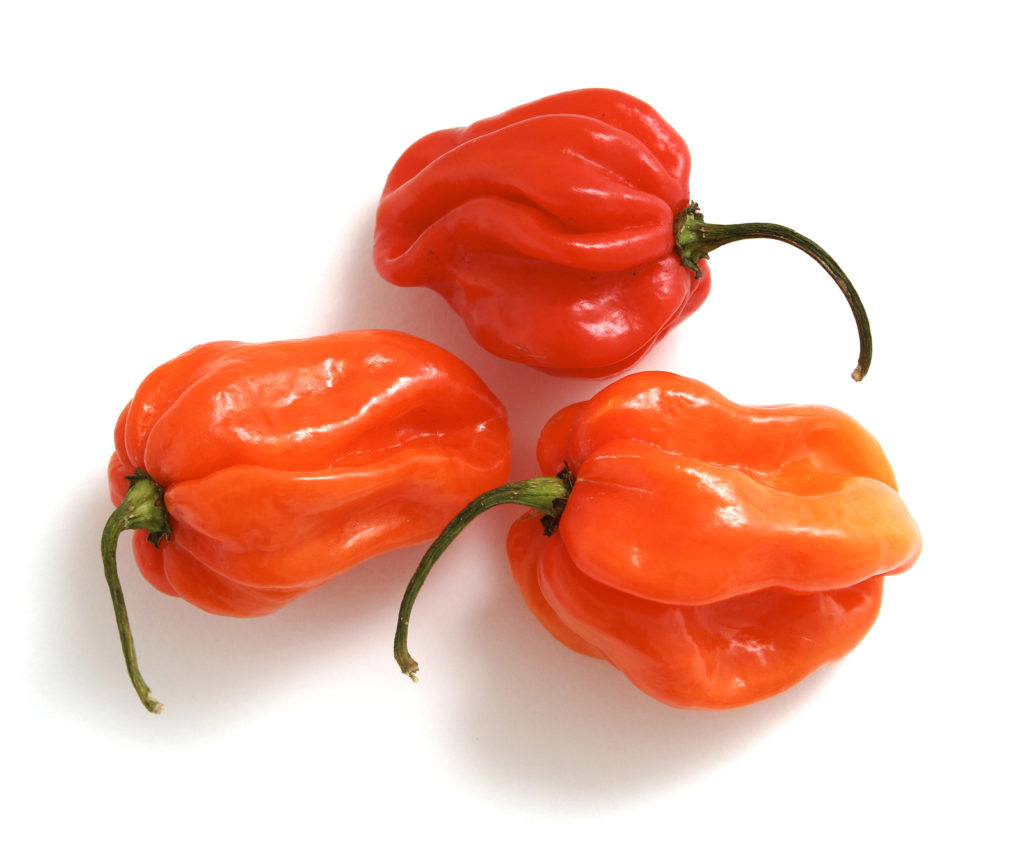
- Scotch bonnet: Has a wrinkled top and flattened base. Light green to yellow to red at maturity. Deep fruity, smoky flavor. Use in Caribbean hot sauces and jerk seasoning. Popular in the Southwestern United States. Widely used in Yucatan and Caribbean cuisines. 200,000 to 300,000 SU.
- Serrano (C. annuum): Small, tubular pods to about 2 inches (5 cm) long; usually harvested medium-green, ripens to bright red; crisp-textured, concentrated fresh, grassy, acidic flavor, very pungent seeds and veins. Use raw in guacamole and some salsa crudas. Use in stuffings and pickles. Named for mountain ridges (serranias) in Mexico where they originated. 10,000 to 25,000 SU.
- Tabasco (C. frutescens): Small, slender fruit to about 1 inch (2.5 cm) long, thin fleshed, yellow, turning orange to scarlet when ripe. Sharp biting taste with a hint of celery. Mostly used to make the famous Louisiana Tabasco hot sauce from seeds first brought from Tabasco, Mexico in about 1848. Popular in the Southwestern United States.
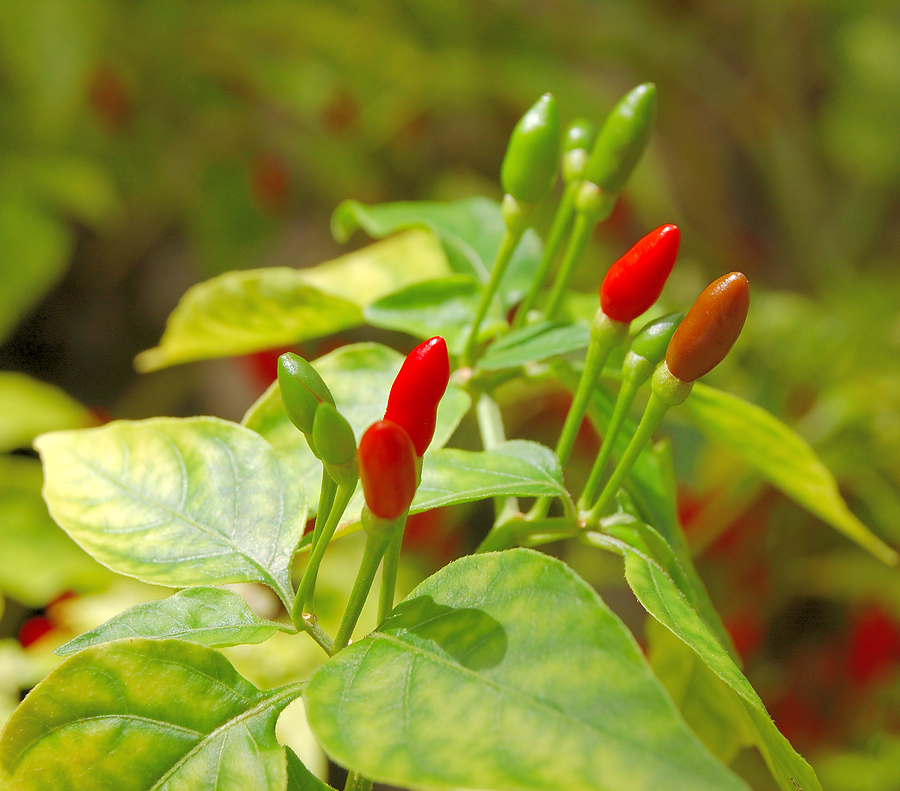
- Thai (C. annuum): Also called Thai dragons: Thin, meaty, cone-shaped, ¾ to 1 inch (1.9 to 2.5) long dark green ripening to bright red pods. Use fresh and dried. Add to curries and stir-fries or chop for pastes and dips. Popular in Asia. 50,000-100,000 SU.
- Yellow Wax Pepper (C. annuum): Also called Hungarian wax pepper or chile guero: Pale, waxy yellow maturing to light red, elongated with pointed tips to about 5 inches (13 cm) long. Use raw in salsas; use toasted and seeded in salads and cooked in stews. Mild to medium hot.
Care in using hot peppers
Because capsaicin resides in the white pith surrounding the seeds in the pepper’s inner wall, you can trim and wash the pith away to dilute the capsaicin, but use disposable kitchen gloves and avoid wiping your eyes or nose or other moist mucus membranes. Wash your hands with vinegar or soap when you are finished working with hot peppers. (The good news when it comes to eating hot peppers—besides the enjoyment you get from spicy food—is that capsaicin can improve digestion by increasing digestive fluids in the stomach and by fighting bacteria that can cause stomach infections.)
Pepper articles at Harvest to Table:
How to Grow Sweet Bell Peppers
How to Plant and Grow Hot Chili Peppers
Six Tips to Grow Peppers for Flavor
7 Tips for Growing Peppers in Pots
How to Harvest and Store Peppers
Five Ways to Cook and Serve Sweet Peppers
Five Ways to Cook and Serve Chili Peppers
Beginner’s Guide to Canning Peppers
Pepper Growing Problems Troubleshooting
Epsom Salt, Milk, and Organic Fertilizers for Tomatoes and Peppers
How to Prevent Blossom Drop — Tomatoes and Peppers
Garden Planning Books at Amazon:
- Tomato Grower’s Answer Book
- Vegetable Garden Almanac & Planner
- Kitchen Garden Grower’s Guide Vegetable Encyclopedia
- Vegetable Garden Grower’s Guide
More how to grow articles:
Learn how to plant, grow, and harvest your favorite vegetables. Click below for all you need to know.
- Artichoke
- Arugula
- Asparagus
- Beans, Snap
- Beets
- Broad Beans
- Broccoli
- Brussels Sprouts
- Cabbage
- Cantaloupe — Melons
- Cardoon
- Carrots
- Cauliflower
- Celeriac
- Celery
- Chard
- Chayote Squash
- Chickpeas
- Chicory
- Chinese Cabbage
- Collards
- Corn Salad
- Corn, Sweet
- Cresses
- Cucumbers
- Eggplant
- Endive and Escarole
- Fava Beans
- Florence Fennel
- Garbanzo Beans
- Garlic
- Horseradish
- Jerusalem Artichoke
- Kale
- Kohlrabi
- Leeks
- Lettuce
- Lima Beans
- Melons
- Mizuna
- Mustard Greens
- New Zealand Spinach
- Okra
- Onions
- Parsnips
- Peanuts
- Peas
- Peppers
- Potatoes
- Pumpkins
- Radicchio
- Radishes
- Rhubarb
- Rutabaga
- Salsify
- Shallots
- Sorrel
- Southern Peas
- Soybeans
- Spinach
- Squash, Summer
- Squash, Winter
- Sunchokes
- Sweet Potato
- Swiss Chard
- Taro
- Tomatillo
- Tomatoes
- Turnips
- Watermelon
- Zucchini















